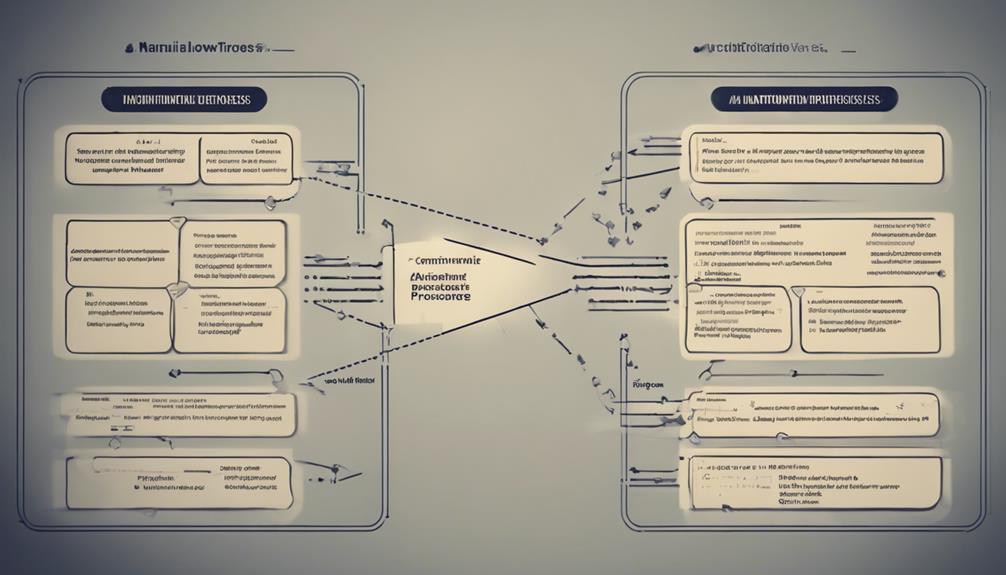To understand chargebacks, grasp various reasons like criminal fraud or friendly fraud. Respond promptly with evidence to contest them effectively, as issuing banks have the final say. Analyzing transactions and customer interactions aids in prevention strategies. Implement fraud filters, address verification, and clear communication to reduce risks. Monitoring chargeback data is important for business efficiency. Contesting chargebacks involves understanding reason codes, providing evidence, and using management tools. Proactive management minimizes revenue loss and boosts fraud detection. Businesses can suffer operational costs and reputational damage from chargebacks. Best practices include secure protocols, clear policies, excellent service, and staff education. Learn more about managing chargeback dynamics for successful dispute resolution.
Key Takeaways
- Know reason codes for effective dispute resolution.
- Submit evidence promptly during investigations.
- Issuing banks make final decisions on chargebacks.
- Implement fraud filters for real-time detection.
- Utilize chargeback management tools for efficient resolution.
Recognizing Chargeback Dynamics

To navigate the intricacies of chargeback dynamics effectively, you must grasp the various reasons that lead to these transaction reversals. Understanding the reason codes associated with chargebacks is essential for merchants in order to effectively dispute them.
When a chargeback occurs, prompt response is key. Merchants should promptly respond to chargeback notices to contest the dispute. This quick action can help in providing the necessary information during the investigation process.
The investigation of chargebacks involves a complex process that includes submitting evidence and ultimately culminates in a decision made by the issuing banks. As a merchant, it's vital to be proactive and thorough in your response to chargebacks.
Being aware of the various stages in the chargeback process and the role of issuing banks can help you navigate this challenging aspect of payment disputes more effectively. By understanding the dynamics involved in chargebacks, you can better position yourself to contest them successfully.
Understanding Chargeback Reasons

Understanding the reasons behind chargebacks is essential for merchants to effectively dispute and prevent these transaction reversals. Chargebacks can occur due to various reasons, including criminal fraud, merchant error, and friendly fraud. Here is a breakdown of these chargeback reasons:
| Reason | Description |
|---|---|
| Criminal Fraud | Unauthorized purchases made with stolen card information by malicious actors. |
| Merchant Error | Mistakes in processing transactions or fulfilling orders by the merchant leading to chargebacks. |
| Friendly Fraud | Intentional or unintentional misuse of the chargeback process by cardholders, causing transaction disputes. |
Analyzing Transaction Records

When analyzing transaction records, you should focus on:
- Reviewing purchase details
- Identifying fraud patterns
- Gathering evidence promptly
By scrutinizing these records, you can pinpoint potential issues that may lead to chargebacks and take proactive measures to address them.
Utilizing technology to automatically flag suspicious transactions can streamline this process and enhance your ability to prevent and mitigate chargebacks effectively.
Reviewing Purchase Details
Analyzing transaction records by reviewing purchase details plays a critical role in identifying patterns and discrepancies essential for effective chargeback dispute resolution. By examining customer information, purchase details, and matching them with chargeback reasons and sales data, merchants can uncover inconsistencies that may assist in resolving disputes.
This thorough review not only aids in dispute resolution but also helps in developing prevention strategies to reduce future chargebacks. Additionally, a detailed analysis of purchase details can reveal areas for improvement in customer service, product delivery, and communication processes.
Understanding the nuances within transaction records is key to mitigating chargeback risks and enhancing overall business operations.
Identifying Fraud Patterns
By closely examining transaction records, you can swiftly pinpoint fraud patterns and potential chargeback triggers. When analyzing transaction data for fraud patterns, consider the following:
- Monitoring customer interactions through transaction records reveals common fraud indicators.
- Detecting unusual purchase behavior or recurring disputes in transactions signals potential fraud.
- Matching chargeback reasons with sales data aids in pinpointing specific fraud patterns for targeted prevention.
- Utilizing Intelligent Source Detection tools can automatically flag suspicious transactions based on historical fraud patterns.
Gathering Evidence Promptly
Promptly gather transaction records to strengthen your evidence in chargeback disputes. Transaction records contain vital information like payment dates, amounts, and customer details.
By analyzing these records promptly, you can accurately match chargeback reasons with sales data, bolstering your case. Additionally, delving into transaction records enables you to identify trends and patterns that could help prevent future disputes.
Timely examination of these records empowers merchants to build a robust argument when disputing chargebacks effectively. Remember, thorough scrutiny of transaction records is key to providing compelling evidence and increasing your chances of successfully challenging chargebacks.
Take the time to analyze and understand this data to protect your business from unwarranted disputes.
Customer Interaction Analysis

When exploring customer interaction analysis, it's important to focus on three key points:
Communication During Disputes,
Resolution Strategies for Disputes, and
Documentation for Dispute Cases.
By understanding how customers communicate during disputes, implementing effective resolution strategies, and maintaining thorough documentation, you can proactively address chargeback issues.
These points serve as essential pillars in mitigating disputes and fostering positive customer interactions.
Communication During Disputes
Analyzing customer interactions reveals important patterns that aid in understanding the root causes of chargebacks. When it comes to communication during disputes, paying attention to certain aspects is essential:
- Monitoring Channels: Keep track of emails, calls, and chats to spot customer grievances and potential chargeback triggers.
- Identifying Breakdowns: Look for communication breakdowns or misunderstandings to resolve disputes and prevent future chargebacks.
- Documenting Interactions: Accurately document customer interactions to have valuable evidence for effectively disputing chargebacks.
- Improving Processes: Use customer feedback to enhance communication processes, leading to better dispute resolution outcomes and fewer chargeback incidents.
Resolution Strategies for Disputes
To effectively resolve disputes through customer interaction analysis, focus on implementing proactive strategies that address underlying issues promptly. Analyzing customer interactions can help uncover patterns that might signal potential disputes, allowing you to intervene early and prevent chargeback disputes.
By monitoring communication channels for any issues, you can preemptively address customer concerns before they escalate into disputes. Understanding customer behavior through interaction analysis not only aids in better dispute resolution but also provides valuable evidence in chargeback disputes.
Documenting customer interactions is essential for building a strong case in dispute resolution scenarios. Utilize the data gathered from customer interactions to enhance customer service, identify chargeback prevention opportunities, and ultimately improve your overall business operations.
Documentation for Dispute Cases
Properly documenting customer interactions is essential for effectively handling dispute cases and building a strong defense against chargebacks. When dealing with customer disputes, keeping detailed records of interactions is important for fighting a chargeback.
Here are key points to keep in mind for documentation in dispute cases:
- Analyze communication logs, emails, chat transcripts, and phone call recordings to gather evidence supporting your case.
- Track customer interactions to identify disputes, understand chargeback reasons, and help resolve the dispute efficiently.
- Understanding the context of customer interactions can provide valuable insights into dispute resolution and prevent future chargeback issues.
- Customer interaction analysis is crucial for recognizing patterns, addressing customer concerns, and strengthening your defense strategy.
Trends in Dispute Identification

When identifying trends in disputes, focus on correlating chargeback reasons with sales data for pinpointing common issues. By analyzing transaction records and matching them with chargeback reasons, you can gain valuable insights into the sources of disputes.
Intelligent Source Detection tools can assist in accurately identifying the origins of disputes, helping you understand the underlying reasons behind chargeback disputes.
Looking for patterns and correlations between customer interactions, chargeback reasons, and sales data is essential for effective dispute resolution strategies and fraud prevention.
Developing Prevention Strategies

Develop a tailored prevention strategy for credit card chargebacks based on your business model and risk profile. To effectively combat friendly fraud and enhance fraud prevention measures, consider the following prevention strategies:
- Implement Fraud Filters: Utilize advanced fraud filters to detect and prevent suspicious transactions.
- Enhance Customer Communication: Maintain clear and open communication with customers to address concerns and prevent misunderstandings that may lead to chargebacks.
- Opt for Chargeback Representment: Engage in chargeback representment services to dispute illegitimate chargebacks effectively.
- Focus on Dispute Resolution: Prioritize prompt refunds, transparent return policies, and efficient dispute resolution processes to minimize the likelihood of chargebacks.
Implementing Fraud Filters

To enhance your payment security measures effectively, implementing fraud filters is crucial in detecting potentially fraudulent activities in real-time. Fraud filters are automated tools that analyze transaction data using predefined rules and patterns to flag suspicious transactions. By utilizing these filters, merchants can reduce the risk of chargebacks by identifying and stopping fraudulent transactions before they occur.
These advanced algorithms provide an additional layer of defense against fraudulent activities, helping to mitigate risks and protect your business from financial losses. By incorporating fraud filters into your payment processing systems, you can boost your overall payment security and create a more secure environment for both your business and your customers.
Through transaction data analysis and the use of fraud filters, merchants can proactively combat fraudulent transactions, ultimately reducing the likelihood of chargebacks and maintaining a trustworthy payment ecosystem. Implementing these automated tools is a strategic approach to risk mitigation and can greatly contribute to the overall security of your payment processes.
Address Verification Services

Address Verification Services (AVS) play an important role in chargebacks by helping merchants confirm the accuracy of customers' billing addresses.
By reducing the risk of fraudulent transactions through address validation, AVS can greatly impact the outcome of disputes.
Ensuring the utmost accuracy in address verification is essential for merchants to prevent chargebacks and maintain transaction security.
Role in Chargebacks
Utilizing Address Verification Services (AVS) plays an important role in minimizing chargebacks by enhancing transaction security through confirming the cardholder's billing address. AVS serves as a vital tool in fraud prevention, reducing the risk of chargebacks stemming from unauthorized transactions.
By ensuring that the address provided by the customer matches the one on file with the card issuer, AVS acts as a preventive measure against potential disputes. This standard security feature supported by card networks and payment processors contributes to overall transaction security, instilling confidence in the validity of transactions.
Merchants can leverage AVS to lower their chargeback rates, establishing a foundation of trust with customers based on secure and verified transactions.
Impact on Disputes
Enhancing transaction security through Address Verification Services (AVS) can greatly impact the resolution of disputes related to chargebacks. AVS plays an essential role in fraud prevention, especially in card-not-present transactions, by verifying the cardholder's billing address.
By cross-referencing the numeric portions of the provided address with the issuing bank's records, AVS adds an extra layer of security, reducing the risk of unauthorized card use. Matching AVS results can help authenticate transactions, potentially lowering the occurrence of chargeback disputes.
Implementing AVS not only enhances transaction security but also contributes to a smoother dispute resolution process for merchants. Overall, AVS serves as a valuable tool to reduce fraud and mitigate the impact of unauthorized transactions on businesses.
Importance of Accuracy
Ensuring the accuracy of billing addresses through Address Verification Services (AVS) is essential in minimizing fraud risk and safeguarding transactions. Utilizing AVS as part of your payment processing strategy can enhance security and reduce the risk of chargeback disputes. Here are some key points to take into account:
- AVS helps verify the cardholder's billing address to minimize fraud risk.
- It compares the address provided during the transaction with the address on file at the issuing bank.
AVS can reduce the likelihood of chargebacks related to unauthorized transactions or identity theft.
- It's a valuable tool in preventing friendly fraud chargebacks by confirming the customer's legitimate billing address.
Clear Customer Communication

Enhancing customer communication clarity can significantly reduce the risk of chargebacks resulting from misunderstandings. Providing detailed information about products, services, and policies is essential in preventing customer confusion that could lead to disputes. Transparency in communication regarding refunds, cancellations, and billing can help build trust with customers, reducing the likelihood of chargebacks stemming from dissatisfaction or confusion.
Responding promptly to customer inquiries and issues is key to preventing escalations that may result in chargebacks. By addressing concerns in a timely and efficient manner, you can resolve issues before they escalate to the point of necessitating a chargeback.
Furthermore, educating customers about the chargeback process and its consequences can act as a deterrent against instances of friendly fraud. By keeping your customers informed and setting clear expectations, you can foster a relationship built on trust and mutual understanding, reducing the occurrence of chargebacks due to misunderstandings or malicious intent.
Monitoring Chargeback Data

To enhance your chargeback management strategy, begin by closely monitoring your chargeback data to track dispute patterns and identify areas for improvement in customer service and fraud prevention. By analyzing your chargeback data, you can gain valuable insights into trends and potential areas of enhancement.
Here are some key points to keep in mind:
- Track the number of disputes and reasons for chargebacks to understand the root causes.
- Identify trends in dispute frequency to proactively address issues that may lead to chargebacks.
- Regularly review chargeback data to adapt fraud prevention strategies and reduce financial losses.
- Stay informed about industry trends through monitoring chargeback data to protect your revenue and adjust your strategies accordingly.
Monitoring your chargeback data not only helps in reducing disputes and financial losses but also in improving overall business operations and customer satisfaction. Stay vigilant and proactive in managing your chargeback data to mitigate risks effectively.
Frequently Asked Questions
How to Challenge a Chargeback?
To challenge a chargeback effectively, gather compelling evidence like proof of delivery and tracking info. Respond promptly within the given timeframe. Know the reason code to prepare a solid rebuttal. Craft a detailed letter with evidence supporting your case.
Engage with the bank, presenting a well-documented argument. Stay proactive and persistent to contest the decision successfully.
How Do You Combat Chargebacks?
To combat chargebacks effectively, you must implement robust authentication measures like CVV or 3D Secure verification.
Educate customers on chargeback consequences to deter misuse.
Utilize representment services to dispute illegitimate chargebacks.
Keep detailed transaction records for evidence.
Stay proactive by reviewing chargeback data, adjusting prevention strategies based on trends, and updating fraud prevention tools.
How Do I Dispute a Chargeback and Win?
To dispute a chargeback effectively and increase your chances of winning, respond promptly with compelling evidence supporting your case. Gather order details, tracking info, and customer communication.
Tailor your response based on the reason code provided with the chargeback. Craft a clear and concise rebuttal letter outlining your evidence and addressing the chargeback reason.
Follow the chargeback process diligently to maximize your chances of success.
What Is Compelling Evidence for Fighting Chargebacks?
To fight chargebacks effectively, compelling evidence includes proof of delivery, signed contracts, and customer communication records. Strong cases are built on detailed order information like tracking numbers and delivery confirmation. Sales receipts, invoices, and proof of product/service fulfillment are essential.
Customer interactions documented through emails, chat logs, and phone call recordings can be powerful tools. Crafting rebuttal letters that address specific chargeback reasons with solid evidence can greatly impact dispute outcomes.
Conclusion
To summarize, understanding the dynamics of chargebacks is essential for businesses to effectively contest them.
By identifying chargeback reasons, analyzing transaction records, and implementing fraud filters, you can enhance your chances of successfully disputing chargebacks.
For instance, a retail store reduced chargebacks by 30% by incorporating address verification services and enhancing customer communication.
By following these strategies, you can better protect your business from unwarranted chargebacks and maintain a healthy financial standing.










